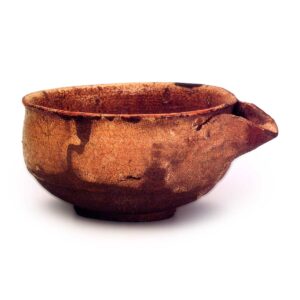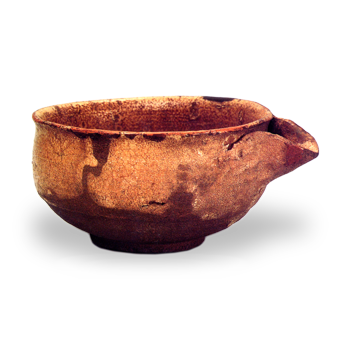
A kitchen utensil. A bowl with a spout on one side. It is useful for transferring liquids such as oil, sake, and soy sauce to a small-mouth container without using a funnel to keep the liquid from leaking out. These bowls are made in various regions as daily utensils. Since they are originally miscellaneous vessels, there is nothing special to note in terms of decoration or shape, but in general, kataguchi vessels from the Owari (Aichi Prefecture) region and its lineage lack a rim above the spout, while those from the Kyushu region have a rim that goes all the way around. It is unknown when the kataguchi style was first introduced. However, there is a Chinese painting from the Han Dynasty that is similar to the kataguchi of the Owari and Mino styles. Therefore, it goes without saying that this form is very old. In the tea ceremony, kataguchi is sometimes used for Wabi-no-chawan (Wabi-no-tea bowl), but this is mostly limited to Karatsu ware. A piece that lacks a spout and is repaired with its fragments is called a tsunagi-koma, while a piece that lacks a spout but leaves a hole in it is called a horema (free horse). In archaeology, a katakuchi is a piece with a partially concave mouth rim or with a half-enclosed tube added to the mouth rim in the form of a pouring spout. It is still intended for pouring liquids. The oldest pottery currently known to have a one-sided mouth is a deep bowl from Early Jomon pottery (Sekiyama style, Kanto region), which has a half-tubular one-sided mouth. Some Yayoi earthenware and earthenware pots also have a one-sided mouth. This is a type of earthenware bowl with a partially concave mouth rim.



